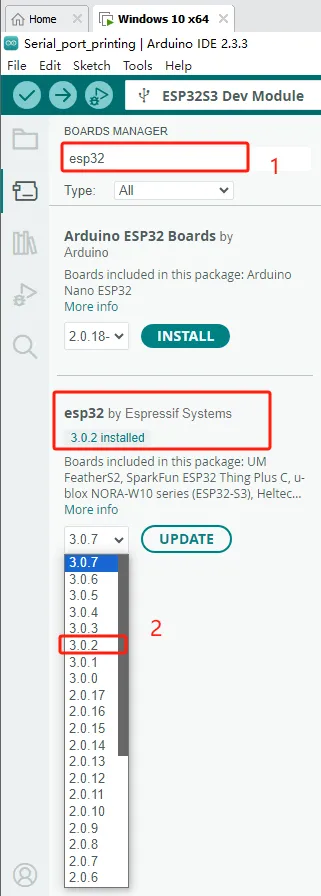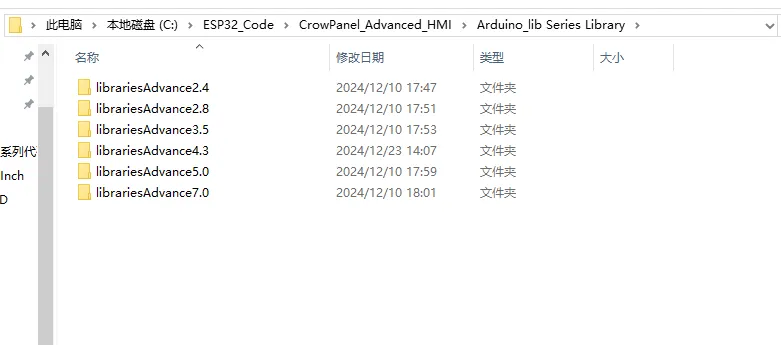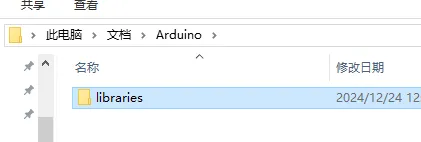4 SD card stores images and displays them locally¶
Welcome to the application tutorial of Lesson 4. The effect to be achieved in this lesson is to store the images that need to be displayed on the SD card and display them on the CrowPanel ESP32 Advance HMI.
This lesson requires everyone to prepare an SD card to store pictures. And a card reader.
1 Select the photos you want to display on the browser and save them on the desktop (the save path can be customized)¶
2 Modify the resolution of the image based on the size of the product you are using.¶
This is the resolution size we accept for each size product.
Here, for large-sized products, I will take the 2.4-inch product as an example to introduce how to modify the resolution of images.
The resolution of the 2.4-inch product is 320x240.
(Note: The image resolution of 7.0-inch, 5.0-inch, and 4.3-inch products is consistent, and the code and image can be used interchangeably.)
First, open the "paint" tool on the computer.
Drag and drop the image into the "paint" tool to readjust the pixels of the image
(Images can be uploaded to the browser and selected according to everyone's preferences)
Adjust the pixel to 2.4-inch screen resolution: 320x240
(If you are using a different size, please set the correct resolution)
Can be referred to:There are resolutions of different sizes as references above. (Second point)
Click confirm
Adjust the resolution of the image as shown in the picture
Save to a folder for easy use (folder path can be customized)
Save in BMP format (must have a 24 bit image depth)
Insert the SD card into the card reader
Open the SD drive, copy the modified image to the SD drive and save it
Exit the SD card and remove the SD card
3 Insert the SD card containing this saved image into your CrowPanel ESP32 Advance HMI¶
(2.4 inch, 2.8 inch, 3.5 inch products can be directly inserted for use)
(After inserting the SD card, turn the function switch to 1 0 mode (TF Card mode) for 4.3-inch, 5.0-inch and 7.0-inch.)
4 Open the code we provide, and you only need to modify the path and name of the image you saved¶
Modify the path of the image you saved
Here, my path is the five images in the current path on the SD card
So the path of my image is the current path "/" plus the image name (1. bmp)
Then display the image in the loop and set the resolution size
(different sizes have different resolutions)
5 Configure the runtime environment and burn code¶
(Before burning, please replace the relevant library files according to different sizes.
How to replace, details in Lesson 2)
6 Phenomenon display¶
The five photos I saved on the SD card will be displayed in a loop.
7 Code reference¶
7.0 inch、5.0inch、4.3inch
#include "pins_config.h"
#include "LovyanGFX_Driver.h"
#include <Wire.h>
#include <SPI.h>
#include <FS.h>
#include <SD.h>
#include <Adafruit_SSD1306.h>
#include <Adafruit_GFX.h>
/* Expand IO */
#include <TCA9534.h>
TCA9534 ioex;
#define SD_MOSI 6
#define SD_MISO 4
#define SD_SCK 5
#define SD_CS 0 //The chip selector pin is not connected to IO
// The image name you stored on the SD card
#define IMAGE_1 "/1.bmp"
#define IMAGE_2 "/2.bmp"
#define IMAGE_3 "/3.bmp"
#define IMAGE_4 "/4.bmp"
#define IMAGE_5 "/5.bmp"
SPIClass SD_SPI = SPIClass(HSPI);
LGFX gfx;
// Display text on the screen
void show_test(int lcd_w, int lcd_h, int x, int y, const char * text) {
gfx.fillScreen(TFT_BLACK);
gfx.setTextSize(3);
gfx.setTextColor(TFT_RED);
gfx.setCursor(x, y);
gfx.print(text);
}
void setup()
{
Serial.begin(115200); // set baud rate
// Init Display
gfx.init();
gfx.initDMA();
gfx.startWrite();
gfx.fillScreen(TFT_BLACK);
delay(500);
Wire.begin(15, 16);
delay(50);
ioex.attach(Wire);
ioex.setDeviceAddress(0x18);
ioex.config(1, TCA9534::Config::OUT);
/* Turn on backlight */
ioex.output(1, TCA9534::Level::H);
if (SD_init() == 0)
{
Serial.println("TF_Card initialization succeeded");
show_test(LCD_H_RES, LCD_V_RES, 350, 230, "SD_Card OK");
delay(3000);
} else {
Serial.println("TF card initialization failed");
show_test(LCD_H_RES, LCD_V_RES, 350, 230, "SD_Card failed");
delay(3000);
}
gfx.setRotation(2);
gfx.fillScreen(TFT_BLACK);
Serial.println( "----- Setup done -----" );
}
void loop()
{
// Cycle printing each image
Serial.println("Refreshing image...1");
displayImage(SD, IMAGE_1, 800, 480);
delay(5000);
Serial.println("Refreshing image...2");
displayImage(SD, IMAGE_2, 800, 480);
delay(5000);
Serial.println("Refreshing image...3");
displayImage(SD, IMAGE_3, 800, 480);
delay(5000);
Serial.println("Refreshing image...4");
displayImage(SD, IMAGE_4, 800, 480);
delay(5000);
Serial.println("Refreshing image...5");
displayImage(SD, IMAGE_5, 800, 480);
delay(5000);
}
// SD card initialization
int SD_init()
{
SPI.begin(SD_SCK, SD_MISO, SD_MOSI, SD_CS);
SD_SPI.begin(SD_SCK, SD_MISO, SD_MOSI);
if (!SD.begin(SD_CS, SD_SPI, 80000000))
{
Serial.println(F("ERROR: File system mount failed!"));
SD_SPI.end();
return 1;
}
else
{
Serial.println("Card Mount Successed");
Serial.printf("SD Size: %lluMB \n", SD.cardSize() / (1024 * 1024));
// hspi->end();
}
listDir(SD, "/", 2);
Serial.println("**** TF Card init finished ****.");
return 0;
}
/*
Function: List files and subdirectories in the specified directory.
Parameters:
- fs: The file system object used to operate on the file system.
- dirname: A pointer to the name of the directory whose contents are to be listed.
- levels: Specifies the depth of recursive listing of subdirectories.
*/
void listDir(fs::FS & fs, const char *dirname, uint8_t levels) {
Serial.printf("Listing directory: %s\n", dirname);
File root = fs.open(dirname); // Open the specified directory.
// If the directory cannot be opened.
if (!root) {
Serial.println("Failed to open directory");
return;
}
// If the opened item is not a directory.
if (!root.isDirectory()) {
Serial.println("Not a directory");
return;
}
File file = root.openNextFile(); // Open the next file in the directory.
// While there are still files.
while (file) {
// If the current file is a directory.
if (file.isDirectory()) {
Serial.print(" DIR : ");
Serial.println(file.name()); // Print the directory name.
// If there are still levels of depth for recursion.
if (levels) {
listDir(fs, file.name(), levels - 1); // Recursively call the function to list the contents of the subdirectory, reducing the depth by 1.
}
}
// If the current file is not a directory, i.e., a regular file.
else {
Serial.print(" FILE: ");
Serial.print(file.name()); // Print the file name.
Serial.print(" SIZE: ");
Serial.println(file.size()); // Print the file size.
}
file = root.openNextFile(); // Continue to open the next file in the directory.
}
}
/*
Function:
- Display image from file
Parameters:
- fs: The file system object
- filename: The name of the BMP image file
- x: The x - coordinate on the screen to start printing the image
- y: The y - coordinate on the screen to start printing the image
Returns:
- 0 if the image is printed successfully, 0 if the file cannot be opened
*/
int displayImage(fs::FS &fs, String filename, int x, int y)
{
File f = fs.open(filename, "r"); // Open the file for reading
if (!f)
{
Serial.println("Failed to open file for reading");
f.close();
return 0; // File open failed, return 0
}
f.seek(54); // Skip the 54 - byte BMP file header
int X = x; // representing the width of the image
int Y = y; // representing the height of the image
uint8_t RGB[3 * X]; // Storage space for RGB data of each row, 320 pixels, 3 bytes per pixel (RGB)
for (int row = 0; row < Y; row++) // Iterate through each row of the image
{
f.seek(54 + 3 * X * row); // Jump to the position of the current row
f.read(RGB, 3 * X); // Read the RGB data of the current row
gfx.pushImage(0, row, X, 1, (lgfx::rgb888_t *)RGB); // Display the data of the current row
}
f.close(); // Close the file
return 0;
}
3.5inch
#include "pins_config.h"
#include "LovyanGFX_Driver.h"
#include <Wire.h>
#include <SPI.h>
#include <FS.h>
#include <SD.h>
#include <Arduino.h>
#include <Adafruit_SSD1306.h>
#include <Adafruit_GFX.h>
#define SD_MOSI 6
#define SD_MISO 4
#define SD_SCK 5
#define SD_CS 7 //The chip selector pin is not connected to IO
// The image name you stored on the SD card
#define IMAGE_1 "/1.bmp"
#define IMAGE_2 "/2.bmp"
#define IMAGE_3 "/3.bmp"
#define IMAGE_4 "/4.bmp"
#define IMAGE_5 "/5.bmp"
SPIClass SD_SPI = SPIClass(HSPI);
LGFX gfx;
// Display text on the screen
void show_test(int lcd_w, int lcd_h, int x, int y, const char * text)
{
gfx.fillScreen(TFT_BLACK);
gfx.setTextSize(3);
gfx.setTextColor(TFT_RED);
gfx.setCursor(x, y);
gfx.print(text);
}
void setup()
{
Serial.begin(115200); //set baud rate
// Init Display
gfx.init();
gfx.initDMA();
gfx.startWrite();
gfx.fillScreen(TFT_BLACK);
delay(500);
/* Turn on backlight */
pinMode(38, OUTPUT);
digitalWrite(38, HIGH);
if (SD_init() == 0)
{
Serial.println("TF card initialization succeeded");
show_test(LCD_H_RES, LCD_V_RES, 125, 135, "SD_Card OK");
delay(3000);
} else {
Serial.println("TF card initialization failed");
show_test(LCD_H_RES, LCD_V_RES, 125, 135, "SD_Card failed");
delay(3000);
}
gfx.setRotation(2);// 7
gfx.fillScreen(TFT_BLACK);
Serial.println( "----- Setup done -----" );
}
void loop()
{
// Cycle printing each image
Serial.println("Refreshing image...1");
displayImage(SD, IMAGE_1, 480, 320);
delay(5000);
Serial.println("Refreshing image...2");
displayImage(SD, IMAGE_2, 480, 320);
delay(5000);
Serial.println("Refreshing image...3");
displayImage(SD, IMAGE_3, 480, 320);
delay(5000);
Serial.println("Refreshing image...4");
displayImage(SD, IMAGE_4, 480, 320);
delay(5000);
Serial.println("Refreshing image...5");
displayImage(SD, IMAGE_5, 480, 320);
delay(5000);
}
// SD card initialization
int SD_init()
{
SD_SPI.begin(SD_SCK, SD_MISO, SD_MOSI);
if (!SD.begin(SD_CS, SD_SPI, 80000000))
{
Serial.println(F("ERROR: File system mount failed!"));
SD_SPI.end();
return 1;
}
else
{
Serial.println("Card Mount Successed");
Serial.printf("SD Size: %lluMB \n", SD.cardSize() / (1024 * 1024));
}
listDir(SD, "/", 2);
Serial.println("**** TF Card init finished ****.");
return 0;
}
/*
Function: List files and subdirectories in the specified directory.
Parameters:
- fs: The file system object used to operate on the file system.
- dirname: A pointer to the name of the directory whose contents are to be listed.
- levels: Specifies the depth of recursive listing of subdirectories.
*/
void listDir(fs::FS & fs, const char *dirname, uint8_t levels) {
Serial.printf("Listing directory: %s\n", dirname);
File root = fs.open(dirname); // Open the specified directory.
// If the directory cannot be opened.
if (!root) {
Serial.println("Failed to open directory");
return;
}
// If the opened item is not a directory.
if (!root.isDirectory()) {
Serial.println("Not a directory");
return;
}
File file = root.openNextFile(); // Open the next file in the directory.
// While there are still files.
while (file) {
// If the current file is a directory.
if (file.isDirectory()) {
Serial.print(" DIR : ");
Serial.println(file.name()); // Print the directory name.
// If there are still levels of depth for recursion.
if (levels) {
listDir(fs, file.name(), levels - 1); // Recursively call the function to list the contents of the subdirectory, reducing the depth by 1.
}
}
// If the current file is not a directory, i.e., a regular file.
else {
Serial.print(" FILE: ");
Serial.print(file.name()); // Print the file name.
Serial.print(" SIZE: ");
Serial.println(file.size()); // Print the file size.
}
file = root.openNextFile(); // Continue to open the next file in the directory.
}
}
/*
Function:
- Display image from file
Parameters:
- fs: The file system object
- filename: The name of the BMP image file
- x: The x - coordinate on the screen to start printing the image
- y: The y - coordinate on the screen to start printing the image
Returns:
- 0 if the image is printed successfully, 0 if the file cannot be opened
*/
int displayImage(fs::FS &fs, String filename, int x, int y)
{
File f = fs.open(filename, "r"); // Open the file for reading
if (!f)
{
Serial.println("Failed to open file for reading");
f.close();
return 0; // File open failed, return 0
}
f.seek(54); // Skip the 54 - byte BMP file header
int X = x; // representing the width of the image
int Y = y; // representing the height of the image
uint8_t RGB[3 * X]; // Storage space for RGB data of each row, 320 pixels, 3 bytes per pixel (RGB)
for (int row = 0; row < Y; row++) // Iterate through each row of the image
{
f.seek(54 + 3 * X * row); // Jump to the position of the current row
f.read(RGB, 3 * X); // Read the RGB data of the current row
gfx.pushImage(0, row, X, 1, (lgfx::rgb888_t *)RGB); // Display the data of the current row
}
f.close(); // Close the file
return 0;
}
2.8inch、2.4inch
#include "pins_config.h"
#include "LovyanGFX_Driver.h"
#include <Wire.h>
#include <SPI.h>
#include <FS.h>
#include <SD.h>
#include <Adafruit_SSD1306.h>
#include <Adafruit_GFX.h>
#define SD_MOSI 6
#define SD_MISO 4
#define SD_SCK 5
#define SD_CS 7 //The chip selector pin is not connected to IO
// The image name you stored on the SD card
#define IMAGE_1 "/1.bmp"
#define IMAGE_2 "/2.bmp"
#define IMAGE_3 "/3.bmp"
#define IMAGE_4 "/4.bmp"
#define IMAGE_5 "/5.bmp"
SPIClass SD_SPI = SPIClass(HSPI);
LGFX gfx;
// Display text on the screen
void show_test(int lcd_w, int lcd_h, int x, int y, const char * text)
{
gfx.fillScreen(TFT_BLACK);
gfx.setTextSize(3);
gfx.setTextColor(TFT_RED);
gfx.setCursor(x, y);
gfx.print(text);
}
void setup()
{
Serial.begin(115200);//set baud rate
// Init Display
gfx.init();
gfx.initDMA();
gfx.startWrite();
gfx.fillScreen(TFT_BLACK);
delay(500);
/* Turn on backlight */
pinMode(38, OUTPUT);
digitalWrite(38, HIGH);
if (SD_init() == 0)
{
Serial.println("TF_Card initialization succeeded");
show_test(LCD_H_RES, LCD_V_RES, 75, 150, "SD_Card OK");
delay(3000);
} else {
Serial.println("TF card initialization failed");
show_test(LCD_H_RES, LCD_V_RES, 75, 150, "SD_Card failed");
delay(3000);
}
gfx.setRotation(2);
gfx.fillScreen(TFT_BLACK);
Serial.println( "----- Setup done -----" );
}
void loop()
{
// Cycle printing each image
Serial.println("Refreshing image...1");
displayImage(SD, IMAGE_1, 320, 240);
delay(5000);
Serial.println("Refreshing image...2");
displayImage(SD, IMAGE_2, 320, 240);
delay(5000);
Serial.println("Refreshing image...3");
displayImage(SD, IMAGE_3, 320, 240);
delay(5000);
Serial.println("Refreshing image...4");
displayImage(SD, IMAGE_4, 320, 240);
delay(5000);
Serial.println("Refreshing image...5");
displayImage(SD, IMAGE_5, 320, 240);
delay(5000);
}
// SD card initialization
int SD_init()
{
SD_SPI.begin(SD_SCK, SD_MISO, SD_MOSI);
if (!SD.begin(SD_CS, SD_SPI, 80000000))
{
Serial.println(F("ERROR: File system mount failed!"));
SD_SPI.end();
return 1;
}
else
{
Serial.println("Card Mount Successed");
Serial.printf("SD Size: %lluMB \n", SD.cardSize() / (1024 * 1024));
}
listDir(SD, "/", 2);
Serial.println("**** TF Card init finished ****.");
return 0;
}
/*
Function: List files and subdirectories in the specified directory.
Parameters:
- fs: The file system object used to operate on the file system.
- dirname: A pointer to the name of the directory whose contents are to be listed.
- levels: Specifies the depth of recursive listing of subdirectories.
*/
void listDir(fs::FS & fs, const char *dirname, uint8_t levels) {
Serial.printf("Listing directory: %s\n", dirname);
File root = fs.open(dirname); // Open the specified directory.
// If the directory cannot be opened.
if (!root) {
Serial.println("Failed to open directory");
return;
}
// If the opened item is not a directory.
if (!root.isDirectory()) {
Serial.println("Not a directory");
return;
}
File file = root.openNextFile(); // Open the next file in the directory.
// While there are still files.
while (file) {
// If the current file is a directory.
if (file.isDirectory()) {
Serial.print(" DIR : ");
Serial.println(file.name()); // Print the directory name.
// If there are still levels of depth for recursion.
if (levels) {
listDir(fs, file.name(), levels - 1); // Recursively call the function to list the contents of the subdirectory, reducing the depth by 1.
}
}
// If the current file is not a directory, i.e., a regular file.
else {
Serial.print(" FILE: ");
Serial.print(file.name()); // Print the file name.
Serial.print(" SIZE: ");
Serial.println(file.size()); // Print the file size.
}
file = root.openNextFile(); // Continue to open the next file in the directory.
}
}
/*
Function:
- Display image from file
Parameters:
- fs: The file system object
- filename: The name of the BMP image file
- x: The x - coordinate on the screen to start printing the image
- y: The y - coordinate on the screen to start printing the image
Returns:
- 0 if the image is printed successfully, 0 if the file cannot be opened
*/
int displayImage(fs::FS &fs, String filename, int x, int y)
{
File f = fs.open(filename, "r"); // Open the file for reading
if (!f)
{
Serial.println("Failed to open file for reading");
f.close();
return 0; // File open failed, return 0
}
f.seek(54); // Skip the 54 - byte BMP file header
int X = x; // representing the width of the image
int Y = y; // representing the height of the image
uint8_t RGB[3 * X]; // Storage space for RGB data of each row, 320 pixels, 3 bytes per pixel (RGB)
for (int row = 0; row < Y; row++) // Iterate through each row of the image
{
f.seek(54 + 3 * X * row); // Jump to the position of the current row
f.read(RGB, 3 * X); // Read the RGB data of the current row
gfx.pushImage(0, row, X, 1, (lgfx::rgb888_t *)RGB); // Display the data of the current row
}
f.close(); // Close the file
return 0;
}
If your code compiles incorrectly, you can check if the ESP32 version number is correct. The ESP32 version number we need for this lesson is 3.0.2.
Secondly, please pay attention to replacing the corresponding size library file.
Select the appropriate library file based on the product screen size
Path reference:C:\ESP32_Code\CrowPanel_Advanced_HMI\Arduino_lib Series Library
I will use the Advance 7.0-inch product as an example for operation
Copy the Libraries Advanced 7.0 folder
Open Arduino IDE runtime library file path
Reference path: C:\Users\14175\Documents\Arduino
Delete the existing libraries folder
Paste the copied library Advanced 7.0 folder into this path
Change the folder name to the original libraries
Library update completed, restart Arduino IDE.
When using other sizes, changing the library file is the same operation































